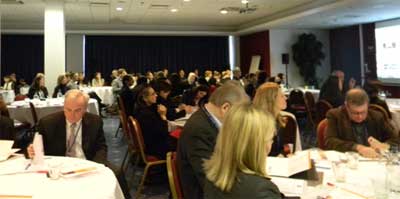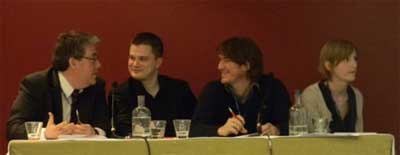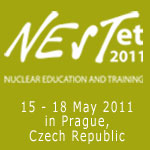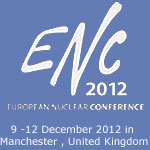

PIME 2011- Communicating nuclear
13 - 16 February 2011, Brussels, Belgium
PIME (Public Information Materials Exchange) is a unique annual conference aimed at improving communications in nuclear sector. The main goal of the conference is to share knowledge on communications tools and strategies and to exchange ideas and network with colleagues from the nuclear field in order to increase public acceptance of the nuclear industry worldwide. PIME 2011 was held in Brussels and 170 nuclear communicators and young professionals from 29 countries from all over the world took part.

This year’s event kicked off with a short press conference on 13 February 2011, which was followed by a welcome cocktail and reception. The reception was sponsored by WiN (Women in Nuclear) Europe, an association that was established on 2 October 2010, in Budapest, Hungary. At the press conference WiN Europe presented its mission, namely to popularize nuclear energy and the nuclear industry with women and to encourage those women already working in the nuclear sector. WiN Europe brings together European women who are active in various fields of nuclear science, including technological applications, the radiation sector, etc. WiN Europe was founded by nine countries (Austria, Finland, France, Germany, Hungary, Romania, Slovenia, Sweden and Switzerland). Other European countries have been approached and invited to join the association in the future.
On 14 February, the first PIME 2011 presentations provided a short introduction to the challenges facing nuclear communicators, with a special focus on new skills and tools for exploiting social media. It was agreed that professionals in the nuclear industry should get more involved in social media, take the initiative rather than wait to be called upon. After all, they need to be pro-active. It was repeatedly emphasized that the old “safer than safe” marketing approach does not work anymore for the nuclear industry and that we definitely need a more innovative nuclear marketing and communications strategy. Social media are available and should be used on a daily basis to promote the nuclear industry. What’s more, we should use them to listen to what our customers are saying about us and our services so that we can react more effectively. Also, it is not important to answer every single question that is asked worldwide. Instead, we have to choose with whom to engage in a debate so that our communications and the debate itself serve a purpose and have an end result.

The plenary session called: What can we learn from other industries was very useful and interesting. Among the issues that were discussed during this session was the fact that the nuclear industry has to, more than ever, focus on providing feedback rather than simply giving information. We have to listen, analyse and process information and provide feedback based on it.
Communications tools have evolved and will continue to do so, but the fundamentals of good communications remain the same. And we should focus on them - simplicity, transparency, participation, virtual community, immediacy, openness, preparedness, etc. All these devices can markedly and positively influence public opinion and acceptance of nuclear energy in the future.

Between two sessions the candidates for the PIME 2011 Award for Communications Excellence were presented. Five short-listed candidates had been pre-selected in recognition of their communications achievements in the nuclear sector (industry, regulatory bodies, research centres, and national organizations), which had successfully connected with their audiences and fellow debaters, thereby helping to dispel common myths and misinformation regarding nuclear energy. These communications efforts have helped to improve the position of the nuclear sector worldwide. The five candidates were: Atomic Energy of Canada Ltd., Andra, Aren/Romatom/Nuclearelectrica SA, Belgian Nuclear Forum and the Hungarian Atomic Energy Authority. The winner of this PIME2011 conference was the Belgian Nuclear Forum, chosen by conference delegates, for the activities they organised at a rock festival. They successfully achieved their goal of sensitising young people to the benefits of nuclear energy and showing them how its multiple applications positively impact upon our lives. They were able to generate a lively dialogue aimed at helping overcome young people’s scepticism regarding nuclear energy.
After Day 1 of the conference participants enjoyed a traditional Belgium dinner in the typical Bruegel setting of the “Caves de Cureghem,” where various artists provided entertainment throughout the evening.
Day 2 of PIME 2011 concentrated on public relations and issues of major public concern. Presentations were given on a range of subjects, including non-proliferation, nuclear new build in Finland and Argentina and waste management and public acceptance in relation to a spent nuclear fuel repository in Sweden. The focus was on key messages, communications tools and target audiences. Argentina, for example, has launched an awareness programme aimed at popularising nuclear energy nationwide and increasing public acceptance (especially among young people) of the second Atucha nuclear unit. In Finland, the promotion of the Okiluoto NPP’s units 3 and 4 started a long time ago, so public opinion in Finland is in favour of nuclear new build. Videos and short clips about the campaigns were also presented.
Day 2 also featured 3 workshops: Communicating with young people, Establishing a dialogue with the local community and Media training for communicators and spokespersons. The workshop devoted to communicating with young people was especially popular (around 45 people attended it). During this workshop it was emphasised that young people are prepared for change, they accept it and they adapt to it very quickly. So, in order to succeed in communicating with them we have to adopt a similar approach. Also, we should definitely be very active, try many different tools to launch simple activities that prove successful with young people. Other tips about communicating with young people were: try to include them in your activity, do not just give an explanation, do not hide information from them, do not be scared of the public since people have the power to talk for you and in your favour (or against you), always control what people are saying about the nuclear sector, challenge young people, dare them to think and offer them a vision of the future so they can see that nuclear energy really has potential!



The final day of PIME 2011 was set aside for a technical tour of the Belgium Nuclear Research Centre, SCK-CEN, at Mol. Participants visited the BR2 reactor there, which has been operational since 1963 and the Hades underground laboratory where issues regarding the storage of radioactive waste underground are addressed. New projects like Myrrha and Guinevere were presented and one group visited the installation of the first lead-based ADS system. It is a critical assembly (kept in a subcritical state) connected to a deuterium accelerator, which together with tritium produces extra neutrons in order to make the reactor critical. This unique and innovative installation is built for the purpose of developing an advanced transmutation system and to investigate radioactive waste transmutation. Also, short visits to the hot cell area and the BR1 reactor were organised.
For 4 days PIME 2011 brought together many nuclear communicators. Lots of important issues were discussed, information from different countries was exchanged and experiences regarding nuclear communications were shared. PIME is definitely a very useful conference for all nuclear public information specialists who wish to enhance and share their know-how and explore new strategies for communicating nuclear.
This was my first “non-technical” conference and I really recommend that people working in nuclear communications visit and actively participate in PIME conferences. My participation definitely made me think more broadly about how nuclear communications are viewed. It also helped me to understand what issues are most important to the public and to young people in particular. This will help us find the right way of communicating with them and explaining all the benefits of nuclear energy, as well as its promise for the future.
Marija Miletić
Research Centre Rez Ltd.
Research Reactors Division
Czech Republic
mil@cvrez.cz |











